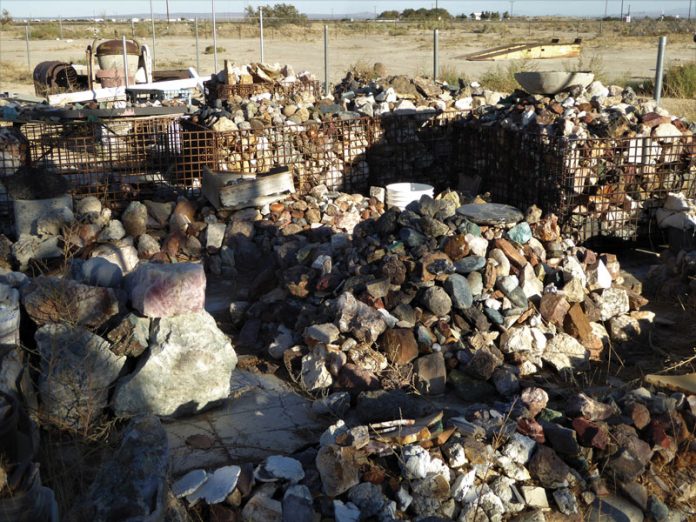
Figuring out what to do with a rock collection that’s too big can happen to rockhounds at any stage of the hobby. They often collect more rocks than they can handle. For instance, I’ve seen many a disorganized backyard rock pile left by the Greatest Generation from the heyday of rockhounding. I once received an email begging to clear a property filled by a deceased rockhound whose heirs were left with the aftermath. So desperate were they, everyone was invited to come in pickup trucks with crates to haul away whatever they could for free.
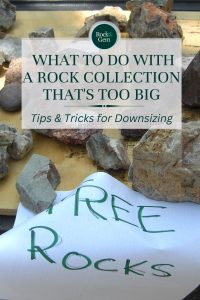
Some collectors’ passion has morphed into an obsession. They’ve not only filled their backyards and garages but are renting storage units. One fine fellow has not one but three, all bursting at the seams. When your home isn’t enough and you now pay to warehouse rocks you picked up for free, you may have one rock too many!
As rocks take over, how do you get a handle on them? I offer a four-step process from personal experiences and rockhound friends.
Step One: Getting Started
First, a disclaimer: Do as I say, not as I do! My own rock pile and collections remain works in progress. Like many others, I deferred to those golden years of retirement to get around to it. Now, buried by rocks, fossils, lapidary rough and equipment, it’s hard to see the specks of gold for the tonnage and I reflect on my mortality. I’ve done the math. There’s no way to craft my way through my pile of lapidary rough. Time to downsize!
Simply getting started on an overwhelming task is the hardest part, especially when viewed at the macro level. A useful mantra to follow is “each day, one thing.”
Consistency is key. Once a habit is established, it’s easier to extend it. For instance, start making it two items a day and by year’s end, 730 items are out of the garage. Never underestimate the cumulative effects of small steps.
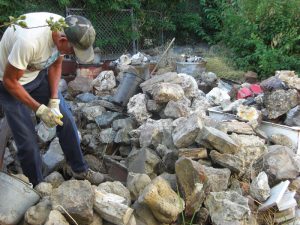 Step Two: Organize What You’ve Got
Step Two: Organize What You’ve Got
As you begin, follow the advice of de-cluttering author Joshua Becker: start with something easy, then work your way up. One easy and even enjoyable task is simply organizing what you’ve got. Working my way through my garage, I’m organizing all my quartz together in flats, all my agates, my trilobites, etc. This allows me to see exactly what I’ve got.
After a trip to the hardware store, I organized my outdoor rock pile by locality and/ or rock type into 40 five-gallon buckets and 30 crates, all lined up on a brick foundation and cinder block shelves. But as my son gazed at my proud feat, he shook his head and asked, “You will get rid of all this before you die, won’t you?”
Appreciate the distinction between “organizing” and “downsizing.” A ton of rocks for your heirs to dispose of is still a ton of rocks whether scattered in heaps or beautifully organized.
Step Three: Conduct a Hard-Nosed High-Grade
There’s a fine line between collecting what you can use, share, and enjoy and hoarding. It’s hoarding when you come across rocks you forgot you had or how you got them.
When you’re new to the hobby, enthusiasm overwhelms discernment. Every rock exudes potential and holds memories of a treasured trip, so you keep them all. You swear you will one day cut and polish each.
Be realistic in walking the line between dreams and deeds and resist the siren call of sentimentality. Take a hard look at the specimen that means so much to you. Was dinged-up quartz even worth collecting? If having trouble disconnecting, assume a positive viewpoint and realize you aren’t downsizing but “rightsizing.” Getting rid of duplicates and junk gives you space and time to focus on the good and right stuff.
If you’ve been collecting for years and you have multiple examples of a particular type of fossil, mineral or lapidary rock. Decide which is best. Get rid of the rest!
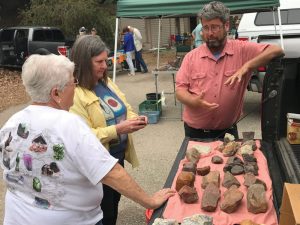
Step Four: Dispose of Surplus
Once you’ve organized and high-graded, start discarding. You have three choices: sell it, give it away, or die and leave the problem to someone else. Tackling this as soon as you can allows you to thoughtfully and leisurely dispose of material rather than having to move things in a hurried “sacrifice sale.”
Do you simply want to get rid of material? Or are you hoping to cash in? Offering your rocks free is the quickest way to see them disappear. Cashing in takes time, with items disappearing one by one rather than in large batches. Here are ways I’ve seen fellow rockhounds approach this.
Selling Your Surplus
The Meisenheimer Method. If you belong to a rock club, you have a ready network. Ray Meisenheimer tapped the shoulders of fellow members with specific interests and invited them to his home. My interest was fossils, and I found a table crowded with them. After I picked and paid for what I wanted and was out the door, Ray shouted, “For an extra hundred, it’s all yours!” Ray knew a sucker when he saw one. He sure got rid of his fossils fast!
A Silver Pick Sale. CFMS Past-President Dick Pankey shrank his rock pile by hosting silver pick sales, selling rough rocks, slabs, and mineral specimens by the crate, by the flat, and by the piece. If opening your rock pile for a sale, though, don’t change your mind midstream. I went to another silver pick sale, and every time I approached the host, he said, “That’s a pretty piece. I don’t think I can give that one up.” Once committed, go through with it!
Silent Auctions. Add excitement to a yard sale by simultaneously hosting silent auctions. Set a table with eye candy and auction sheets with minimum starting bids and hold half-hour rounds. If pieces are enticing, this generates a fair amount of cash to supplement the more modest income from the yard sale, where rocks typically are sold for a buck or so a pound.
Tailgate Sales. Some rock clubs host tailgate sales. Members gather in trucks and cars, lower tailgates or open trunks and sell specimens. But don’t get your hopes up. At one, I came home with more rocks than I had left with.
Online Sales. Many avenues exist for reaching out to customers. Think online sites like eBay or Etsy. However, selling one item at a time is a slow slog. Reserve it for high-end stuff bringing high-end yield.
Sales on Commission. Some dealers are willing to sell your stuff on commission at rock shows or in a rock shop. Package a couple flats with labels to facilitate the dealer’s efforts.
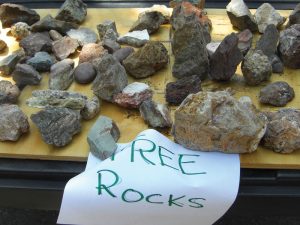
Giving Surplus Away
The approaches just described may yield pocket change, but your rock pile will only slowly dwindle given that most rockhounds are reluctant to pull out silver picks unless they see a ridiculously great deal. If money’s not your thing, give your surplus away.
Start with Family. If you have family with an interest, give them first crack at taking what they want.
Donate to Your Local Club. Nonprofit rock clubs are happy to take donations. Those sponsoring shows often conduct sales where they can convert your free rocks into cash for the club. They also need small rocks to fill grab bags and to use with kids’ programs.
Make it Educational. Donate to a museum or college. Museums prefer quality items with provenance. Children’s museums may take items that can be used in activities or sold in gift shops. Geology departments have classes where they use specimens for identification exercises.
Make It a Free-for-All! When a group of siblings advertised they were disposing of their parents’ lifetime rock pile, rockhounds from across the county showed up holding 5-gallon buckets and wads of cash. When told all rocks were free for the taking, folks were stunned. One person finally broke the silence: “We gotta get more buckets!”
The Ultimate Solution: Cab ’em as you Grab ’em
The way to avoid all this is by following the American Federation of Mineralogical Societies Code of Ethics: “I will…take home only what I can reasonably use…I will practice conservation and undertake to utilize fully and well the materials I have collected and will recycle my surplus for the pleasure and benefit of others.”
I sum up the ultimate solution with “Cab ‘em as you grab ‘em.” Practice just-in-time collecting of rocks and slabs, judiciously collecting or purchasing as needed then working them right away. Storage problem solved! Then again, there’s one person’s tongue-in-cheek suggestion: collect only micro-mounts. Now that’s downsizing!
Words From the Experts
In our acquisition-oriented society, an entire profession has sprung up to help downsize. There’s even a National Association of Productivity & Organizing Professionals with Certified Professional Organizers. Here are three to consider.
Marie Kondo, The Life-Changing Magic of Tidying Up (2014). Kondo is described as the “home-organizing and clutter-clearing phenomenon.” Her advice? Pile your stuff, pick out only that which gives you joy, then thank the rest as you discard it. Her two-word mantra? “Spark joy.” As an aside, in an interview with Westways magazine, Kondo was asked what travel item she packs on trips: “My crystals. I travel with them to purify the space where I’m staying. They’re beautiful and spark joy for me.”
Margareta Magnusson, The Gentle Art of Swedish Death Cleaning: How to Free Yourself and Your Family from a Lifetime of Clutter (2017). Magnusson lays out precepts of Swedish “Death Cleaning” or döstädning. Death cleaning doesn’t imply the grim reaper is at the door. It simply urges us to get affairs in order, which is good practice at any life stage. You do so by removing unnecessary things; things you don’t even see anymore, much less value. Not only do you unclutter your own life, you save loved ones the anxiety and time consumed in disposing of another’s belongings.
Joshua Becker, The Minimalist Home: A Room-by-Room Guide to a Decluttered, Refocused Life (2018). Per Becker, minimalism frees you from possessions you don’t want, need or use. Instead of surrounding yourself with huge collections of low-quality odds and ends, aim for quality from the start. I’ve kept many specimens from collecting trips. A lot of junk; just a few true keepers. I’ve also gone to gem shows and purchased many “affordable” minerals and fossils. But low price tags add up to quite a dollar amount when aggregated. Instead, I could have used my money to make just a couple high-quality, high-priced purchases at each of the shows.
Sparking joy. Death cleaning. Minimalism. Pick your term. The important thing is taking your first step. It’s time to downsize!
This story about what to do with a rock collection that’s too big appeared in Rock & Gem magazine. Click here to subscribe. Story and Photography by Jim Brace-Thompson.














